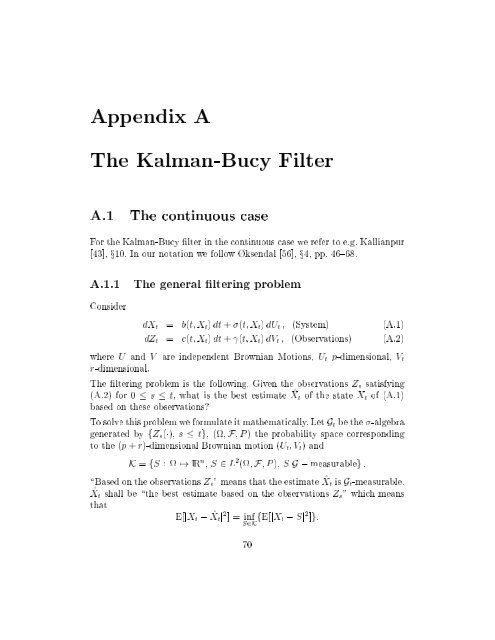Estimation in Financial Models - RiskLab
Estimation in Financial Models - RiskLab
Estimation in Financial Models - RiskLab
Create successful ePaper yourself
Turn your PDF publications into a flip-book with our unique Google optimized e-Paper software.
Appendix A<br />
The Kalman-Bucy Filter<br />
A.1 The cont<strong>in</strong>uous case<br />
For the Kalman-Bucy lter <strong>in</strong> the cont<strong>in</strong>uous case we refer to e.g. Kallianpur<br />
[43], x10. In our notation we follow ksendal [56], x4, pp. 46{68.<br />
A.1.1<br />
The general lter<strong>in</strong>g problem<br />
Consider<br />
dX t = b(t; X t ) dt + (t; X t ) dU t ; (System) (A.1)<br />
dZ t = c(t; X t ) dt + (t; X t ) dV t ; (Observations) (A.2)<br />
where U and V are <strong>in</strong>dependent Brownian Motions, U t p-dimensional, V t<br />
r-dimensional.<br />
The lter<strong>in</strong>g problem is the follow<strong>in</strong>g. Given the observations Z s satisfy<strong>in</strong>g<br />
(A.2) for 0 s t, what is the best estimate ^X t of the state X t of (A.1)<br />
based on these observations?<br />
To solve this problem we formulate it mathematically. Let G t be the -algebra<br />
generated by fZ s (); s tg, (; F;P) the probability space correspond<strong>in</strong>g<br />
to the (p + r)-dimensional Brownian motion (U t ;V t ) and<br />
K = fS : 7! IR n ; S 2 L 2 (; F;P); SG,measurableg :<br />
\Based on the observations Z s " means that the estimate ^X t is G t -measurable.<br />
^X t shall be \the best estimate based on the observations Z s " which means<br />
that<br />
E[jX t , ^X t j 2 ]= <strong>in</strong>f<br />
S2K fE[jX t , Sj 2 ]g:<br />
70
















